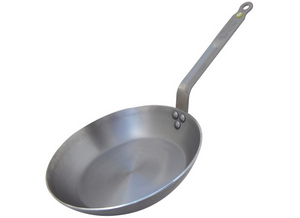Among the most traditional of skillets, the French rolled steel pan is the European version of the cast iron frying pan in the United States. Where the American style skillet has fairly straight sides and is too bulky to sauté in with any ease, the French style pan has the gently sloped sides and a somewhat lighter weight, making it ideal for sauté work.
For a number of years these were difficult to find, and when you could find them, they were often the cheapest and most poorly made versions of this classic. With the gourmet renaissance of the 21st century in full swing, however, this kitchen classic has resurfaced in excellent form. One of the very best of which is the De Buyer model, offered in sizes ranging from a modest 8″ up to a truly vast 14″ with a helper handle. For this article I used a 10″ De Buyer Mineral Pan.
Rolled steel pans have been available with three finishes for many years: natural steel, black steel and blue steel. The older pans in my collection came as natural finished pans, in plain white steel, and I cured them to their blackened glory. Black steel pans come pre-cured, and blue steel pans have a finish on them similar to gun bluing, which supposedly renders the pans more stick and rust resistant. With care, I have always preferred my natural steel pans. DeBuyer makes two variants of the natural steel pan. The lighter weight version they refer to as their “Grandmother” style pan. It has a welded handle and fairly thin metal. These pans are less expensive and they work well on most household ranges. The Mineral Pan, on the other hand, is top of the steel pan line. The metal is thick and the handle is riveted to the pan. These are true war horses of the kitchen.
DeBuyer makes some rather veiled claims that their Mineral Pans contribute valuable iron to the diet. I have not been able to find any solid scientific evidence of this claim, and if you are low on dietary iron, I would strongly suggest that you consult a dietician or just start taking a good quality iron supplement rather than relying on iron transfer from a natural steel pan.
The best feature of the steel pan is its ability to withstand the application of high heat. On the stove top I have had these pans up to 800°F as registered on the infrared thermometer. In the oven, 500°F is a comfortable area for them. Be warned, however, that the ribbon steel handles on these get as hot as the pans in the oven, and kitchen towels are not made to withstand 500°F temperatures. I keep a pair of thick leather welding gloves in the kitchen for the purpose of evacuating casseroles from the oven, and they are the perfect protection against red-hot steel pan handles too!
Because of the high heats that these pans are capable of, they are the perfect tools for putting a good brown sear on a meat. Furthermore, if you are interested in blackening meats or fish in the Cajun style, these pans can handle those extreme heats too, though those extreme temperatures may damage the cure, and you will have to re-season the pan subsequently.
Due to these pans elegantly sloped shape, they are also perfect for sauté work, allowing small foods like cut vegetables or mushrooms to be flipped back upon themselves gracefully. The shape is also conducive to well formed traditional omelets and crepes. DeBuyer does make an excellent, dedicated crepe pan, but I find that the 10″ sauté works perfectly.
Like the upside, the downside of these pans is also in their weight. As mentioned, DeBuyer makes a lighter weight household version of the rolled steel pans. Steel, like cast iron, is heavy, and when choosing a sauté pan, cooks will want to consider this and choose an appropriate material for their use. The weight allows for even heating with no hot spots on the pan, but it also makes the pan difficult to use unless you have forearms like Popeye.
The care needed for a steel pan is a bit more intensive than for aluminum or stainless steel. Obviously, you cannot put a carbon steel pan in the dishwasher, nor can you put it in a sink of soapy water. As with cast iron, you wipe it out after it is used. If you need to you can boil it out on the stove top with plain water. If it needs some real scrubbing, use a handful of kosher salt and a lemon half – the gentle abraisive of the salt will not damage the cure, and the acid will help to dissolve the cooked on dirt. That said, under normal circumstances, a paper towel wipe-down is sufficient to keep these pans clean.
Our overall impression of this pan was very positive. These are our go-to kitchen tools for most applications requiring sauté pans. The investment is fairly small, and they are built to last – your grandchildren will still be using these in their kitchens.



